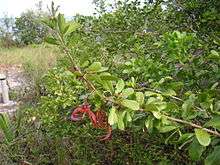Pithecellobium
Pithecellobium is a genus of flowering plants in the legume family, Fabaceae. The generic name is derived from the Greek words πιθηκος (pithekos), meaning "ape" or "monkey," and ελλοβιον (ellobion), meaning "earring," which refers to the coiled shape of the fruit pods.[3] Plants of the genus are known generally as blackbeads.[4]
| Pithecellobium | |
|---|---|
 | |
| Pithecellobium keyense | |
| Scientific classification | |
| Kingdom: | |
| (unranked): | |
| (unranked): | |
| (unranked): | |
| Order: | |
| Family: | |
| Subfamily: | |
| (unranked): | |
| Genus: | Pithecellobium |
| Species | |
|
See text | |
| Synonyms[2] | |
| |
Species
There are about 75 species in the genus:[5]
- Pithecellobium albicaule Britton & Rose
- Pithecellobium bahamense Northr.
- Pithecellobium benthamianum
- Pithecellobium bertolonii Benth.
- Pithecellobium bifoliolatum
- Pithecellobium bijugatum
- Pithecellobium bipinnatum L.Rico
- Pithecellobium brevipes
- Pithecellobium brownii Standl.
- Pithecellobium caesalpinioides
- Pithecellobium campechense
- Pithecellobium candidum
- Pithecellobium circinale (L.)Benth.
- Pithecellobium cochliocarpum
- Pithecellobium concinnum Pittier
- Pithecellobium confertum Benth. also known as everfresh
- Pithecellobium cordifolium
- Pithecellobium cynodonticum Barneby & J.W.Grimes
- Pithecellobium decandrum
- Pithecellobium discolor
- Pithecellobium diversifolium
- Pithecellobium domingense
- Pithecellobium dulce (Roxb.) Benth. – guamúchil, ebony blackbead, monkeypod (Mexico, Central America, northern South America)
- Pithecellobium elachistophyllum
- Pithecellobium elegans
- Pithecellobium excelsum (Kunth) Mart.
- Pithecellobium filipes (Vent.)Benth.
- Pithecellobium flavovirens
- Pithecellobium furcatum Benth.
- Pithecellobium glaucescens
- Pithecellobium guaraniticum
- Pithecellobium guaricense
- Pithecellobium guatemalense
- Pithecellobium gummiferum
- Pithecellobium halogenes
- Pithecellobium hansemannii
- Pithecellobium histrix (A.Rich.) Benth.
- Pithecellobium hymenaeafolium (Willd.)Benth.
- Pithecellobium insigne Micheli
- Pithecellobium jiringa
- Pithecellobium johansenii Standl. (Belize, Guatemala, Honduras)
- Pithecellobium keyense Coker – Florida Keys blackbead
- Pithecellobium laetum
- Pithecellobium lanceolatum
- Pithecellobium larensis
- Pithecellobium lentiscifolium
- Pithecellobium leucosericeum
- Pithecellobium longipendulum
- Pithecellobium macrandrium
- Pithecellobium maestrense
- Pithecellobium marthae
- Pithecellobium mataybifolium
- Pithecellobium micradenium
- Pithecellobium microchlamys
- Pithecellobium mucronatum
- Pithecellobium nicoyanum
- Pithecellobium obliquifoliolatum
- Pithecellobium oblongum Benth.
- Pithecellobium obovale
- Pithecellobium pachypus Pittier
- Pithecellobium peckii S.F.Blake
- Pithecellobium pistaciifolium
- Pithecellobium platycarpum Merr.
- Pithecellobium roseum – buche colorado
- Pithecellobium salutare
- Pithecellobium seleri Harms (Guatemala, Honduras)
- Pithecellobium spinulosum
- Pithecellobium splendens
- Pithecellobium steyermarkii
- Pithecellobium striolatum
- Pithecellobium tenue Craib
- Pithecellobium tonduzii
- Pithecellobium tuerckheimii
- Pithecellobium unguis-cati (L.)Benth. – catclaw blackbead
- Pithecellobium velutinum
- Pithecellobium vietnamense I.C.Nielsen
Formerly placed here
Many species now in the genera Albizia and Abarema were formerly classified in Pithecellobium. Other species previously included:
- Archidendron bigeminum (as P. bigeminum, P. gracile, P. nicobaricum)
- Chloroleucon foliolosum (as P. foliolosum, P. grisebachianum, P. myriophyllum Malme, P. oligandrum)
- Pseudosamanea cubana (as P. bacona)
- Zygia cognata (as P. cognatum, P. stevensonii)
- Zygia pithecolobioides (as P. pithecolobioides, P. reductum)
gollark: It's probably possible to go way higher.
gollark: You can quite easily pack 9KB of data onto a sheet of paper with a laser printer or something.
gollark: Just because you *can* pack lots of data onto paper, doesn't mean you *should*.
gollark: See, that's *better*.
gollark: no.
References
| Wikimedia Commons has media related to Pithecellobium. |
| Wikispecies has information related to Pithecellobium |
- The Legume Phylogeny Working Group (LPWG). (2017). "A new subfamily classification of the Leguminosae based on a taxonomically comprehensive phylogeny". Taxon. 66 (1): 44–77. doi:10.12705/661.3.
- "Pithecellobium Mart". Germplasm Resources Information Network. United States Department of Agriculture. 2007-10-05. Archived from the original on 2009-05-07. Retrieved 2010-01-27.
- Austin, D. F. (2004). Florida Ethnobotany. CRC Press. p. 517. ISBN 978-0-8493-2332-4.
- Pithecellobium. Integrated Taxonomic Information System (ITIS).
- Pithecellobium. The Plant List.
This article is issued from Wikipedia. The text is licensed under Creative Commons - Attribution - Sharealike. Additional terms may apply for the media files.
